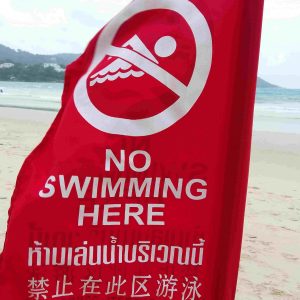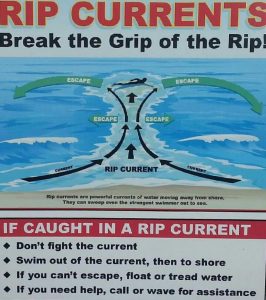Information, Phuket
Safety & Swimming – How to avoid Rip Currents
Safety & Swimming at Phuket Top Best Beaches.
Phuket has it share of some of the best beaches in Thailand, with millions of tourist each year attracted to the the top beach resort making Phuket possibly being the busiest Island in Thailand.
Top Beach locations in Phuket are mainly located on the Western coastline, Nai Harn, Ya Nui, Kata Noi, Kata, Karon, Patong, Freedom, Kamala, Lem Singh, Bangtao, and Surin Beach.
For those tourist who visit Phuket and cannot swim the local beaches can be a dangerous place, common sense tells you that the safest place to start learning to swim would be in a swimming Pool under the guidance of a swimming Coach.
If you are a long term beach lover and a swimmer then you will know what a Red flag means, if you have never been to the beach then a “Red Flags identifies a No Swimming Areas”.
Anyone stupid enough to swim in a Red flagged area not only puts their own lives at risk but also beach Lifeguards and Rescue team.
The majority of fatal accidents at beaches are preventable if people follow simple safety rules, guidelines and local advice.
How to avoid Rip currents? Swimmers can first look for “Red flag warnings” and safety information Signs displayed at most popular beach locations.

“Red flags on the beaches warn swimmers not to enter the water but many tourist simply ignore these warnings”
Life Guards and Tourist rescue center staff are often called to rescue good swimmers who get into difficulty, but for those who cannot swim well and choose to Ignore Red flag warnings, you are likely to become a victim of your own stupidity and this can sadly results in your own Death.
Rip Currents
Rip Currents are the Ocean’s Deadliest Trick – and the main reason for accidents.
Globally rip currents account for 80% of all beach rescues with dangerous or deadly consequences for victims or rescuers.
Worldwide statistics highlight “Rip currents will kill more people than shark attacks, or even hurricanes”.
How to spot a Rip Current.
In general most wave directions push water onto the beach through the action of breaking waves and uniformly the backwash water can dissipate and escape back to the ocean along the shore without creating a problem for surfers and Swimmers.
As waves travel toward the beach the wave moves into increasingly shallow water, the bottom of the wave decreases speed and there comes a point where the top of the wave overtakes it and starts to break, spilling forward.
Rip Currents are caused when the returning volume of water of a braking wave called “backwash water” is restricted and cannot dissipate along the full shoreline uniformly, the volume of breaking back wash water can form a (feeder Rip) due to sand bars or underwater feature on a deeper section of the beach floor where returning water picks up speed at the deepest point causing faster-moving water to becomes a rip current.

The Rip current water can flow quickly, typically around 5 miles per hour or eight feet per second faster than an Olympic swimmer, the flowing water can take taking people quickly out to sea.
Rip currents are generally not very wide, but may pull a swimmer out past the breaking waves into deep water, rips can also even circulate out to sea then back to shore.
Its a fact that 70% of people can’t spot a rip current,when you think about swimming look out for local safety information – warning signs and Red Flags in areas patrolled by Phuket Life Guards. Its important that you should know how to swim before you go into the ocean. Think about your own personal swimming ability when swimming alone, and if swimming with friends “can they swim as good as you”
Local rip currents are mainly found along the Western coastal resorts, beach shore lines and headlands. Conditions at local beaches can be more dangerous around the same period as the Western Monsoons between May – October.
Rip currents can occur at anytime of the year when off shore tropical storms exist, typically when there’s high winds are approaching from the West.
Characteristics of a Rip Current.
At the beach look for Big waves, the bigger the waves the stronger the rip currents. Look for the Red Flag warnings.
Rip currents are strong, narrow jets of water that move away from the beach and into the ocean.
- Look for deep dark patches of calm water.
- Lack of Wave action – surf that has less fewer breaking waves in some points
- Rippled surface or areas of smooth waters.
- Foaming discolored sandy waters.
- If the beach has flags swim between the area marked between the red and Yellow flags only.
- Rip currents are at their strongest at low tide..
What to do if you find yourself caught in a Rip
If you try to fight the rip current and swim against it, you’ll just get worn out and possibly Panic.
- The main thing you’re going to want to do is maintain floating.
- Call, scream or shout for help immediately if you can’t swim well.
- Don’t try swimming back toward shore in a Rip current is the worst action you can take, you will quickly get overexerted.
- Signal for Help – wave you arms to attract attention “yell for help”
- Remain calm if a rip current begins to pull you away from shore.
- Swim parallel to shore to try and get out of the pull of the rip current.
- If you can stay and float, chances are you might get in a circle current and you end back at the beach again
- Swim toward the shore once you escape the current.
If you are on shore and see someone caught in a rip do not try to be the hero and go in after them, call for help or throw in something that floats. Trained Lifeguards will only attempt a rescue with a flotation device.
Rip tides & under tows..
A riptide is caused by the moon’s gravitational pull and is a predictable rise and fall of the water level. Riptide is an extremely strong current that occurs when the ocean tide pulls water through a small area such as a bay, lagoon or other confined body of water. Riptides occur during the ebb tide and are reversing currents.
An undertow occurs when large waves break at a beach, the up-rush and backwash of water occur in quick succession. When one of these large waves breaks over a swimmer’s head, he feels as if he is being dragged under the water. Undertows are currents that can pull you underwater to the bottom of the ocean.
Be Safe and the best advice to non swimmers is to “stay out of the water.”
